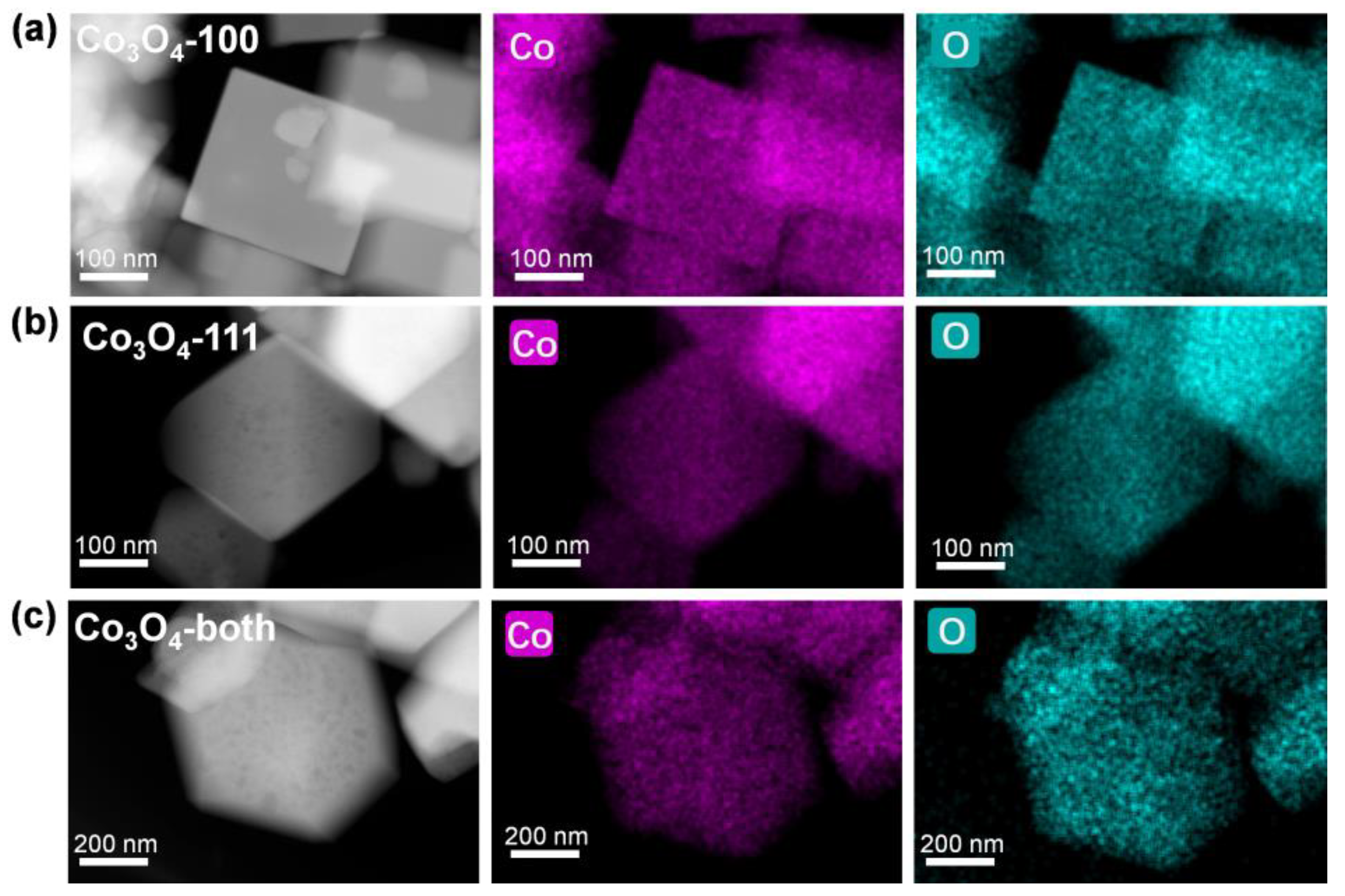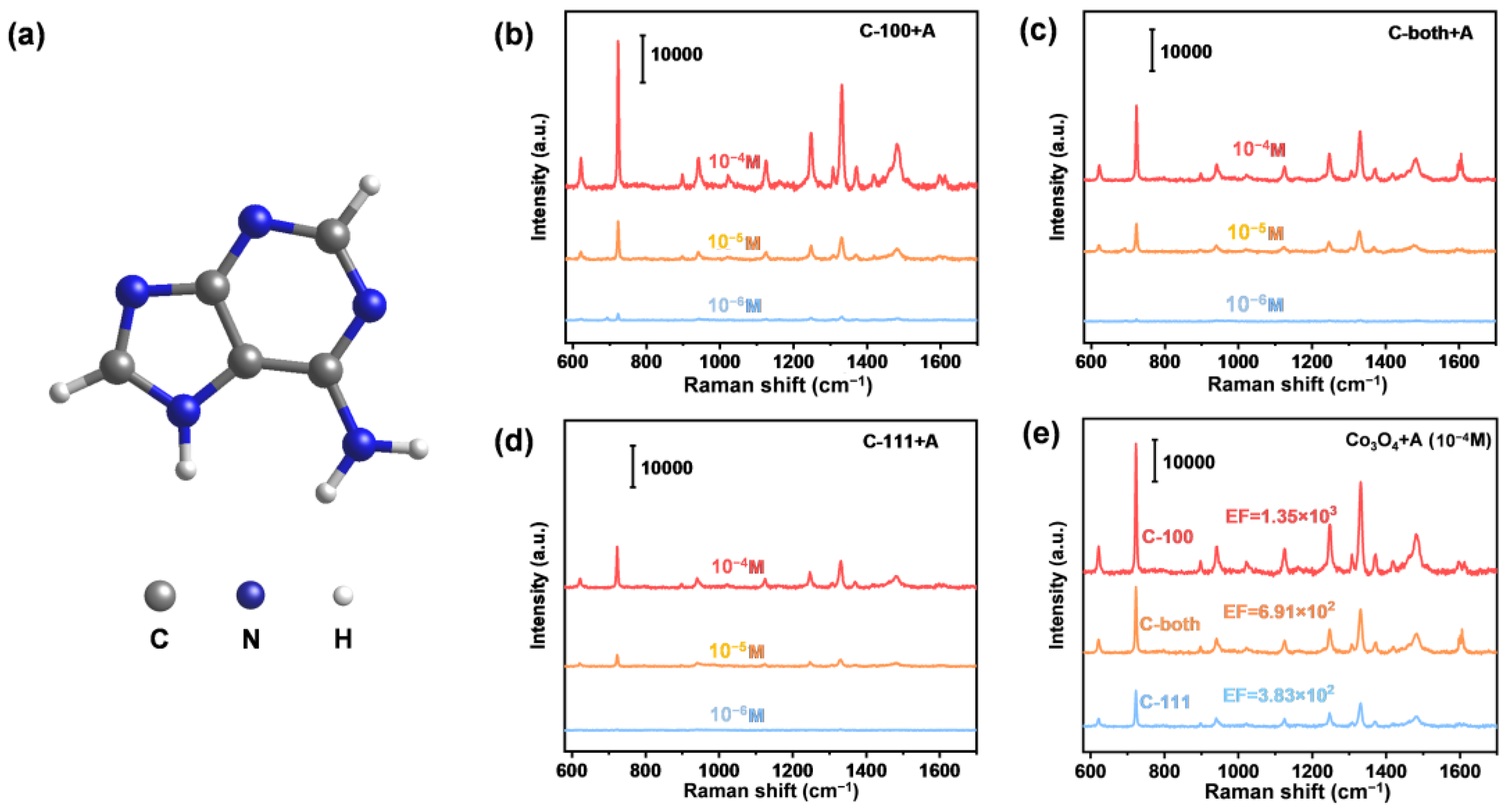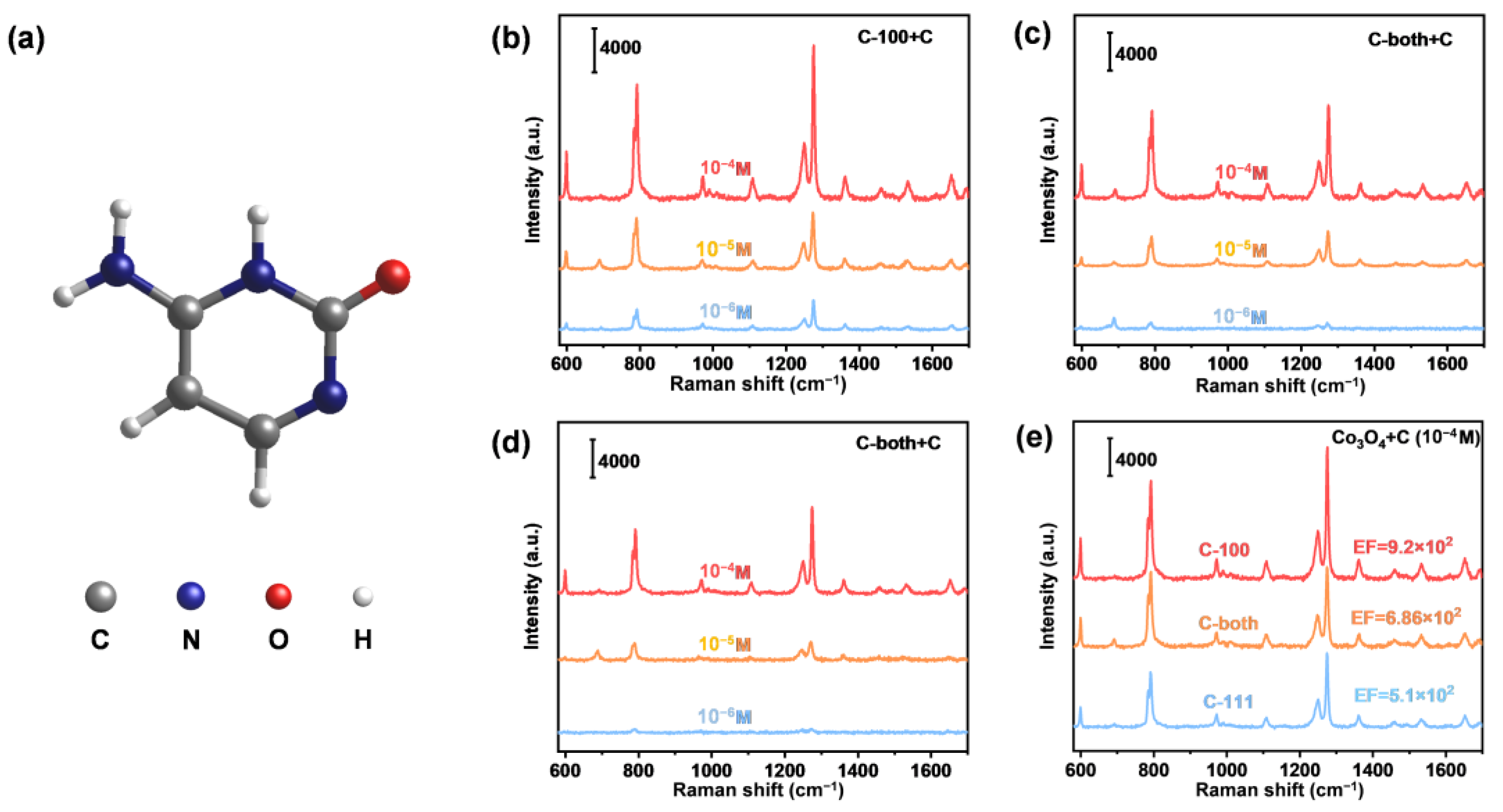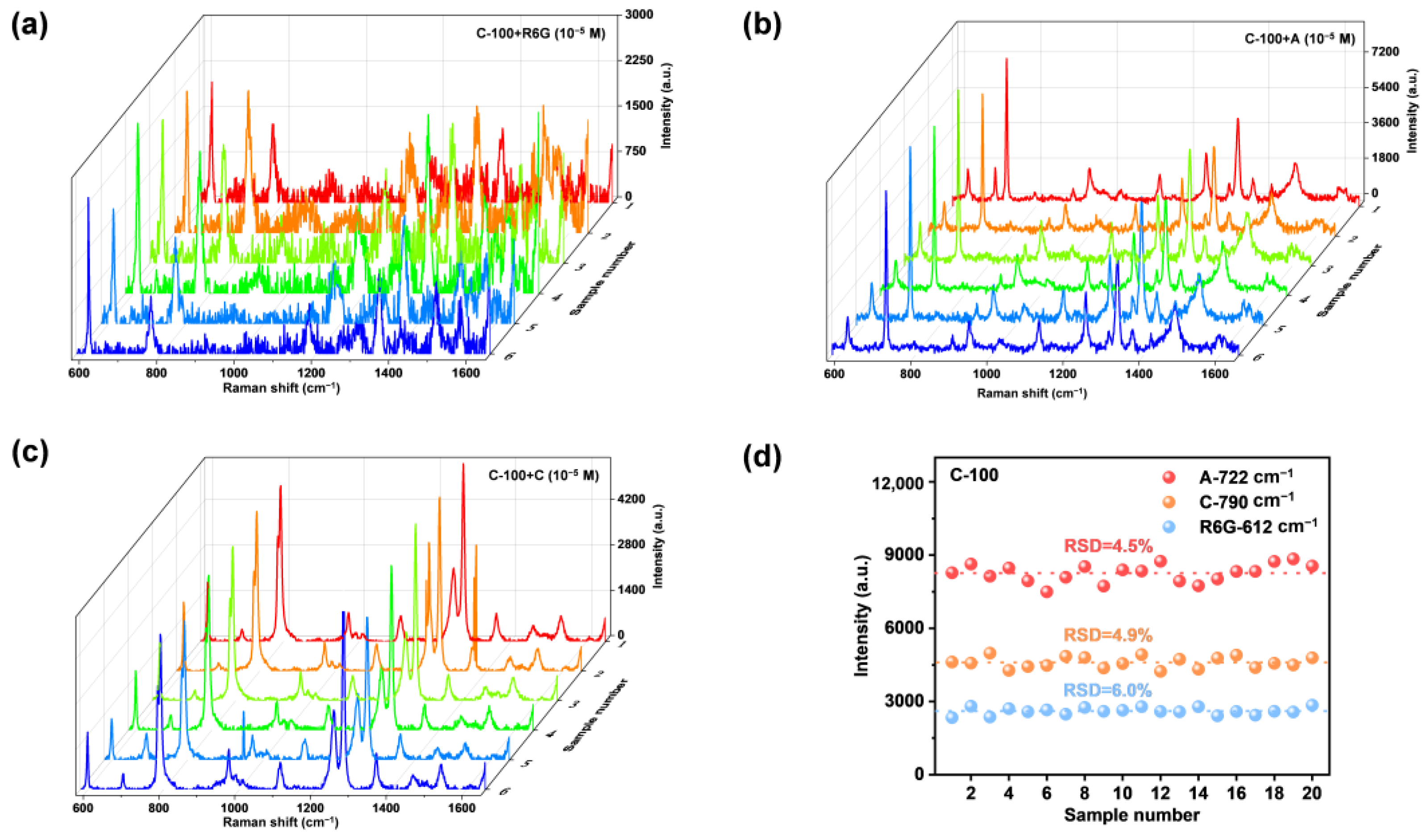Facet-Dependent SERS Activity of Co3O4
Abstract
1. Introduction
2. Results and Discussion
2.1. Characterization of Faceted Co3O4 Microcrystals
2.2. SERS Activities of Faceted Co3O4 Microcrystals
2.3. SERS Reproducibility and Stability of Faceted Co3O4 Microcrystals
2.4. SERS Mechanism of Faceted Co3O4 Microcrystals
3. Materials and Methods
3.1. Materials
3.2. Synthesis of Facet Co3O4 Microcrystals
3.3. Characterization
3.4. SERS Measurements
3.5. Enhancement Factor Calculation
3.6. DFT Calculations
4. Conclusions
Supplementary Materials
Author Contributions
Funding
Institutional Review Board Statement
Informed Consent Statement
Data Availability Statement
Acknowledgments
Conflicts of Interest
References
- Lee, S.H.; Kim, S.; Yang, J.-Y.; Mun, C.; Lee, S.; Kim, S.-H.; Park, S.-G. Hydrogel-Assisted 3D Volumetric Hotspot for Sensitive Detection by Surface-Enhanced Raman Spectroscopy. Int. J. Mol. Sci. 2022, 23, 1004. [Google Scholar] [CrossRef]
- Yang, B.; Jin, S.; Guo, S.; Park, Y.; Chen, L.; Zhao, B.; Jung, Y.M. Recent Development of SERS Technology: Semiconductor-Based Study. ACS Omega 2019, 4, 20101–20108. [Google Scholar] [CrossRef]
- Zhou, X.; Hu, Z.; Yang, D.; Xie, S.; Jiang, Z.; Niessner, R.; Haisch, C.; Zhou, H.; Sun, P. Bacteria Detection: From Powerful SERS to Its Advanced Compatible Techniques. Adv. Sci. 2020, 7, 2001739. [Google Scholar] [CrossRef] [PubMed]
- Lee, H.K.; Lee, Y.H.; Koh, C.S.L.; Phan-Quang, G.C.; Han, X.; Lay, C.L.; Sim, H.Y.F.; Kao, Y.-C.; An, Q.; Ling, X.Y. Designing surface-enhanced Raman scattering (SERS) platforms beyond hotspot engineering: Emerging opportunities in analyte manipulations and hybrid materials. Chem. Soc. Rev. 2019, 48, 731–756. [Google Scholar] [CrossRef] [PubMed]
- Sharma, B.; Frontiera, R.R.; Henry, A.-I.; Ringe, E.; Van Duyne, R.P. SERS: Materials, applications, and the future. Mater. Today 2012, 15, 16–25. [Google Scholar] [CrossRef]
- Kresse, G.; Furthmüller, J. Efficient iterative schemes for ab initio total-energy calculations using a plane-wave basis set. Phys. Rev. B 1996, 54, 11169–11186. [Google Scholar] [CrossRef]
- Fleischmann, M.; Hendra, P.J.; McQuillan, A.J. Raman spectra of pyridine adsorbed at a silver electrode. Chem. Phys. Lett. 1974, 26, 163–166. [Google Scholar] [CrossRef]
- Chou Chau, Y.F.; Chou Chao, C.T.; Huang, H.J.; Kooh, M.R.R.; Kumara, N.; Lim, C.M.; Chiang, H.P. Ultrawide Bandgap and High Sensitivity of a Plasmonic Metal-Insulator-Metal Waveguide Filter with Cavity and Baffles. Nanomaterials 2020, 10, 2030. [Google Scholar] [CrossRef]
- Cong, S.; Yuan, Y.; Chen, Z.; Hou, J.; Yang, M.; Su, Y.; Zhang, Y.; Li, L.; Li, Q.; Geng, F.; et al. Noble metal-comparable SERS enhancement from semiconducting metal oxides by making oxygen vacancies. Nat. Commun. 2015, 6, 7800. [Google Scholar] [CrossRef]
- Yilmaz, M.; Babur, E.; Ozdemir, M.; Gieseking, R.L.; Dede, Y.; Tamer, U.; Schatz, G.C.; Facchetti, A.; Usta, H.; Demirel, G. Nanostructured organic semiconductor films for molecular detection with surface-enhanced Raman spectroscopy. Nat. Mater. 2017, 16, 918–924. [Google Scholar] [CrossRef]
- Alessandri, I.; Lombardi, J.R. Enhanced Raman Scattering with Dielectrics. Chem. Rev. 2016, 116, 14921–14981. [Google Scholar] [CrossRef] [PubMed]
- Lombardi, J.R.; Birke, R.L. Theory of Surface-Enhanced Raman Scattering in Semiconductors. J. Phys. Chem. C 2014, 118, 11120–11130. [Google Scholar] [CrossRef]
- Ansah, I.B.; Lee, S.H.; Mun, C.; Kim, D.-H.; Park, S.-G. Interior Hotspot Engineering in Ag–Au Bimetallic Nanocomposites by In Situ Galvanic Replacement Reaction for Rapid and Sensitive Surface-Enhanced Raman Spectroscopy Detection. Int. J. Mol. Sci. 2022, 23, 11741. [Google Scholar] [CrossRef] [PubMed]
- Chau, Y.-F.C.; Lin, C.-J.; Kao, T.S.; Wang, Y.-C.; Ming Lim, C.; Kumara, N.T.R.N.; Chiang, H.-P. Enhanced photoluminescence of DCJTB with ordered Ag-SiO2 core–shell nanostructures via nanosphere lithography. Results Phys. 2020, 17, 103168. [Google Scholar] [CrossRef]
- Zheng, Z.; Cong, S.; Gong, W.; Xuan, J.; Li, G.; Lu, W.; Geng, F.; Zhao, Z. Semiconductor SERS enhancement enabled by oxygen incorporation. Nat. Commun. 2017, 8, 1993. [Google Scholar] [CrossRef]
- Polubotko, A.M.; Chelibanov, V.P. The theory of SERS on semiconductor and dielectric substrates. Opt. Spectrosc. 2017, 122, 937–943. [Google Scholar] [CrossRef]
- Wang, X.; Shi, W.; She, G.; Mu, L. Surface-Enhanced Raman Scattering (SERS) on transition metal and semiconductor nanostructures. Phys. Chem. Chem. Phys. 2012, 14, 5891–5901. [Google Scholar] [CrossRef]
- Qi, D.; Lu, L.; Wang, L.; Zhang, J. Improved SERS Sensitivity on Plasmon-Free TiO2 Photonic Microarray by Enhancing Light-Matter Coupling. J. Am. Chem. Soc. 2014, 136, 9886–9889. [Google Scholar] [CrossRef]
- Kim, J.; Jang, Y.; Kim, N.-J.; Kim, H.; Yi, G.-C.; Shin, Y.; Kim, M.H.; Yoon, S. Study of Chemical Enhancement Mechanism in Non-plasmonic Surface Enhanced Raman Spectroscopy (SERS). Front. Chem. 2019, 7, 582. [Google Scholar] [CrossRef]
- Lin, J.; Yu, J.; Akakuru, O.U.; Wang, X.; Yuan, B.; Chen, T.; Guo, L.; Wu, A. Low temperature-boosted high efficiency photo-induced charge transfer for remarkable SERS activity of ZnO nanosheets. Chem. Sci. 2020, 11, 9414–9420. [Google Scholar] [CrossRef]
- Peng, Y.; Lin, C.; Long, L.; Masaki, T.; Tang, M.; Yang, L.; Liu, J.; Huang, Z.; Li, Z.; Luo, X.; et al. Charge-Transfer Resonance and Electromagnetic Enhancement Synergistically Enabling MXenes with Excellent SERS Sensitivity for SARS-CoV-2 S Protein Detection. Nano-Micro Lett. 2021, 13, 52. [Google Scholar] [CrossRef] [PubMed]
- He, Z.; Rong, T.; Li, Y.; Ma, J.; Li, Q.; Wu, F.; Wang, Y.; Wang, F. Two-Dimensional TiVC Solid-Solution MXene as Surface-Enhanced Raman Scattering Substrate. ACS Nano 2022, 16, 4072–4083. [Google Scholar] [CrossRef] [PubMed]
- Wu, H.; Wang, H.; Li, G. Metal oxide semiconductor SERS-active substrates by defect engineering. Analyst 2017, 142, 326–335. [Google Scholar] [CrossRef]
- Sun, H.; Wang, X.; Wu, P.; Jiang, H.; Tang, J. Nonstoichiometric tungsten oxide nanosheets with abundant oxygen vacancies for defects-driven SERS sensing. J. Raman Spectrosc. 2022, 53, 1880–1889. [Google Scholar] [CrossRef]
- Zhou, X.; Zhao, X.; Gu, S.; Xie, F.; Wang, X.; Tang, Z. Sulfur doped MoO2 hollow nanospheres as a highly sensitive SERS substrate for multiple detections of organic pollutants. Anal. Methods 2021, 13, 2679–2687. [Google Scholar] [CrossRef] [PubMed]
- Pan, F.; Zhou, G.; Huang, L.; Li, W.; Lin, M.; Liu, C. Interfacial potassium induced enhanced Raman spectroscopy for single-crystal TiO2 nanowhisker. Chin. J. Chem. Eng. 2020, 28, 889–895. [Google Scholar] [CrossRef]
- Song, G.; Gong, W.; Cong, S.; Zhao, Z. Ultrathin Two-Dimensional Nanostructures: Surface Defects for Morphology-Driven Enhanced Semiconductor SERS. Angew. Chem. Int. Ed. 2021, 60, 5505–5511. [Google Scholar] [CrossRef]
- Wang, X.; Shi, W.; Wang, S.; Zhao, H.; Lin, J.; Yang, Z.; Chen, M.; Guo, L. Two-Dimensional Amorphous TiO2 Nanosheets Enabling High-Efficiency Photoinduced Charge Transfer for Excellent SERS Activity. J. Am. Chem. Soc. 2019, 141, 5856–5862. [Google Scholar] [CrossRef] [PubMed]
- Zhao, S.; Wang, H.; Niu, L.; Xiong, W.; Chen, Y.; Zeng, M.; Yuan, S.; Fu, L. 2D GaN for Highly Reproducible Surface Enhanced Raman Scattering. Small 2021, 17, 2103442. [Google Scholar] [CrossRef]
- Bian, K.; Schunk, H.; Ye, D.; Hwang, A.; Luk, T.S.; Li, R.; Wang, Z.; Fan, H. Formation of self-assembled gold nanoparticle supercrystals with facet-dependent surface plasmonic coupling. Nat. Commun. 2018, 9, 2365. [Google Scholar] [CrossRef]
- Zheng, X.; Guo, H.; Xu, Y.; Zhang, J.; Wang, L. Improving SERS sensitivity of TiO2 by utilizing the heterogeneity of facet-potentials. J. Mater. Chem. C 2020, 8, 13836–13842. [Google Scholar] [CrossRef]
- Sabur, A.; Havel, M.; Gogotsi, Y. SERS intensity optimization by controlling the size and shape of faceted gold nanoparticles. J. Raman Spectrosc. 2008, 39, 61–67. [Google Scholar] [CrossRef]
- Lin, J.; Hao, W.; Shang, Y.; Wang, X.; Qiu, D.; Ma, G.; Chen, C.; Li, S.; Guo, L. Direct Experimental Observation of Facet-Dependent SERS of Cu2O Polyhedra. Small 2018, 14, 1703274. [Google Scholar] [CrossRef] [PubMed]
- Luo, Y.; Niu, L.; Wang, Y.; Wen, P.; Gong, Y.; Li, C.; Xu, S. Experimental and theoretical evaluation of crystal facet exposure on the charge transfer and SERS activity of ZnO films. Nanoscale 2022, 14, 16220–16232. [Google Scholar] [CrossRef] [PubMed]
- Sun, Q.; Wang, X.; Wang, H.; Zhang, H.; He, Q.; Zhang, Y.; Cheng, Y.; Zhang, X.; Shi, S.; Tao, L.; et al. Crystal facet effects of platinum single-atom catalysts in hydrolytic dehydrogenation of ammonia borane. J. Mater. Chem. A 2022, 10, 10837–10843. [Google Scholar] [CrossRef]
- Zhong, J.; Zeng, Y.; Zhang, M.; Feng, W.; Xiao, D.; Wu, J.; Chen, P.; Fu, M.; Ye, D. Toluene oxidation process and proper mechanism over Co3O4 nanotubes: Investigation through in-situ DRIFTS combined with PTR-TOF-MS and quasi in-situ XPS. Chem. Eng. J. 2020, 397, 125375. [Google Scholar]
- Vennela, A.; Mangalaraj, D.; Muthukumarasamy, N.; Agilan, S.; Hemalatha, K. Structural and optical properties of Co3O4 nanoparticles prepared by sol-gel technique for photocatalytic application. Int. J. Electrochem. Sci 2019, 14, 3535–3552. [Google Scholar] [CrossRef]
- An, K.; Chen, M.; He, B.; Ai, H.; Wang, W.; Zhang, Z.; Pan, Z.; Chen, S.; Ip, W.F.; Lo, K.H.; et al. Wafer-Scale 2H-MoS2 Monolayer for High Surface-enhanced Raman Scattering Performance: Charge-Transfer Coupled with Molecule Resonance. Adv. Mater. Technol. 2022, 7, 2200217. [Google Scholar]
- Pandey, P.; Kunwar, S.; Shin, K.-H.; Seo, M.-K.; Yoon, J.; Hong, W.-K.; Sohn, J.-I. Plasmonic Core–Shell–Satellites with Abundant Electromagnetic Hotspots for Highly Sensitive and Reproducible SERS Detection. Int. J. Mol. Sci. 2021, 22, 12191. [Google Scholar]
- Gao, D.; Yang, X.; Teng, P.; Kong, D.; Liu, Z.; Yang, J.; Luo, M.; Li, Z.; Wen, X.; Yuan, L.; et al. On-line SERS detection of adenine in DNA based on the optofluidic in-fiber integrated GO/PDDA/Ag NPs. Sens. Actuators B Chem. 2021, 332, 129517. [Google Scholar]
- Tegegne, W.A.; Su, W.-N.; Beyene, A.B.; Huang, W.-H.; Tsai, M.-C.; Hwang, B.-J. Flexible hydrophobic filter paper-based SERS substrate using silver nanocubes for sensitive and rapid detection of adenine. Microchem. J. 2021, 168, 106349. [Google Scholar] [CrossRef]
- Wu, P.F.; Fan, X.Y.; Xi, H.Y.; Pan, N.; Shi, Z.Q.; You, T.T.; Gao, Y.K.; Yin, P.G. Multifunctional self-assembled gold nanorod monolayer/Ti3C2Tx nanocomposites based on interfacial electrostatic for highly sensitive SERS detection of organic dyes and adenine. J. Alloys Compd. 2022, 920, 165978. [Google Scholar] [CrossRef]
- Chen, R.; Li, J.; Li, X.; Wang, J.; Huang, T.; Liu, W.; Dong, F. Unraveling the Unique Role of Methyl Position on the Ring-Opening Barrier in Photocatalytic Decomposition of Xylene Isomers. ACS Catal. 2022, 12, 8363–8371. [Google Scholar] [CrossRef]
- Ye, Y.; Yi, W.; Liu, W.; Zhou, Y.; Bai, H.; Li, J.; Xi, G. Remarkable surface-enhanced Raman scattering of highly crystalline monolayer Ti3C2 nanosheets. Sci. China Mater. 2020, 63, 794–805. [Google Scholar] [CrossRef]
- Blöchl, P.E. Projector augmented-wave method. Phys. Rev. B 1994, 50, 17953–17979. [Google Scholar] [CrossRef]
- Hammer, B.; Hansen, L.B.; Nørskov, J.K. Improved adsorption energetics within density-functional theory using revised Perdew-Burke-Ernzerhof functionals. Phys. Rev. B 1999, 59, 7413. [Google Scholar] [CrossRef]
- Grimme, S.; Antony, J.; Ehrlich, S.; Krieg, H. A consistent and accurate ab initio parametrization of density functional dispersion correction (DFT-D) for the 94 elements H-Pu. J. Chem. Phys. 2010, 132, 154104. [Google Scholar] [CrossRef]
- Chen, J.; Selloni, A. Electronic states and magnetic structure at the Co3O4 (110) surface: A first-principles study. Phys. Rev. B 2012, 85, 085306. [Google Scholar] [CrossRef]
- García-Muelas, R.; Li, Q.; López, N. Density Functional Theory Comparison of Methanol Decomposition and Reverse Reactions on Metal Surfaces. ACS Catal. 2015, 5, 1027–1036. [Google Scholar] [CrossRef]







Publisher’s Note: MDPI stays neutral with regard to jurisdictional claims in published maps and institutional affiliations. |
© 2022 by the authors. Licensee MDPI, Basel, Switzerland. This article is an open access article distributed under the terms and conditions of the Creative Commons Attribution (CC BY) license (https://creativecommons.org/licenses/by/4.0/).
Share and Cite
Feng, Y.; Wang, J.; Hou, J.; Zhang, X.; Gao, Y.; Wang, K. Facet-Dependent SERS Activity of Co3O4. Int. J. Mol. Sci. 2022, 23, 15930. https://doi.org/10.3390/ijms232415930
Feng Y, Wang J, Hou J, Zhang X, Gao Y, Wang K. Facet-Dependent SERS Activity of Co3O4. International Journal of Molecular Sciences. 2022; 23(24):15930. https://doi.org/10.3390/ijms232415930
Chicago/Turabian StyleFeng, Yibo, Jiaxing Wang, Jixiang Hou, Xu Zhang, Yuhang Gao, and Kaiwen Wang. 2022. "Facet-Dependent SERS Activity of Co3O4" International Journal of Molecular Sciences 23, no. 24: 15930. https://doi.org/10.3390/ijms232415930
APA StyleFeng, Y., Wang, J., Hou, J., Zhang, X., Gao, Y., & Wang, K. (2022). Facet-Dependent SERS Activity of Co3O4. International Journal of Molecular Sciences, 23(24), 15930. https://doi.org/10.3390/ijms232415930





